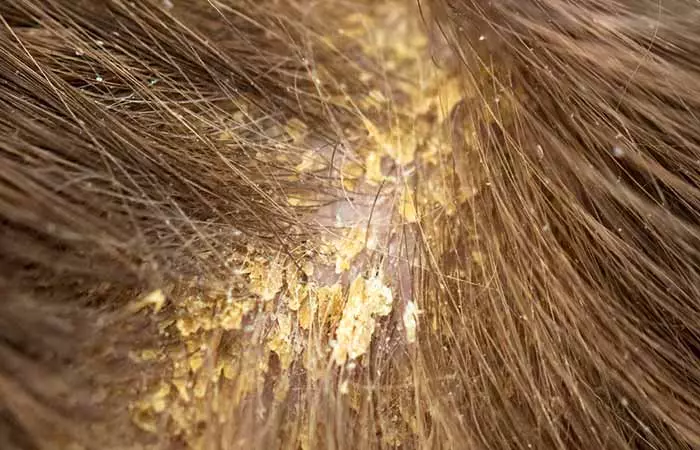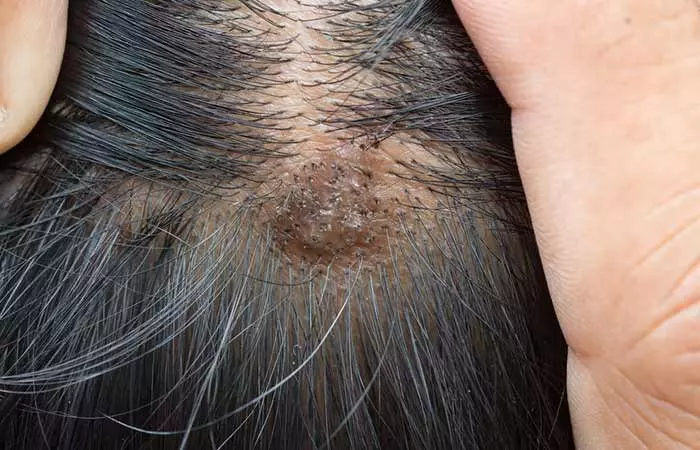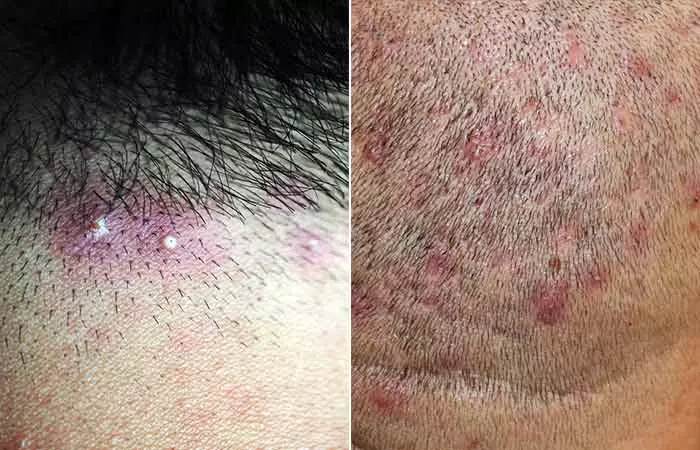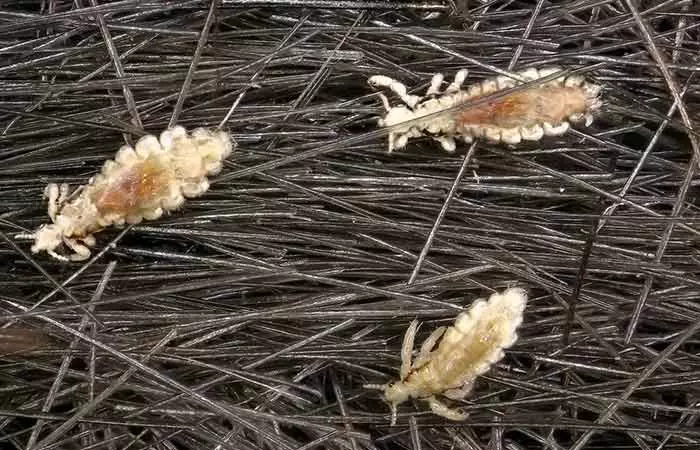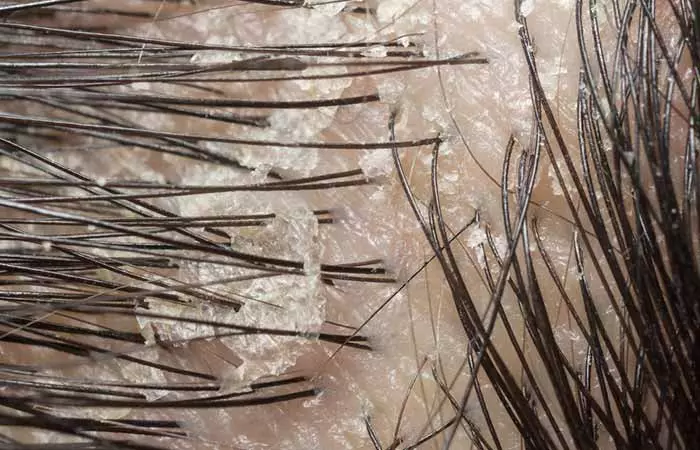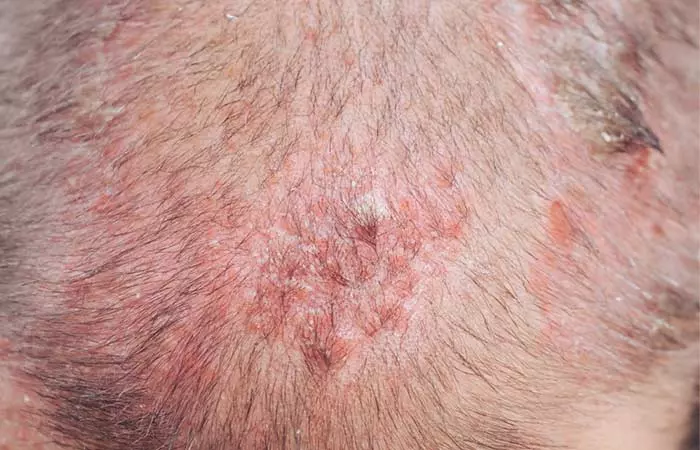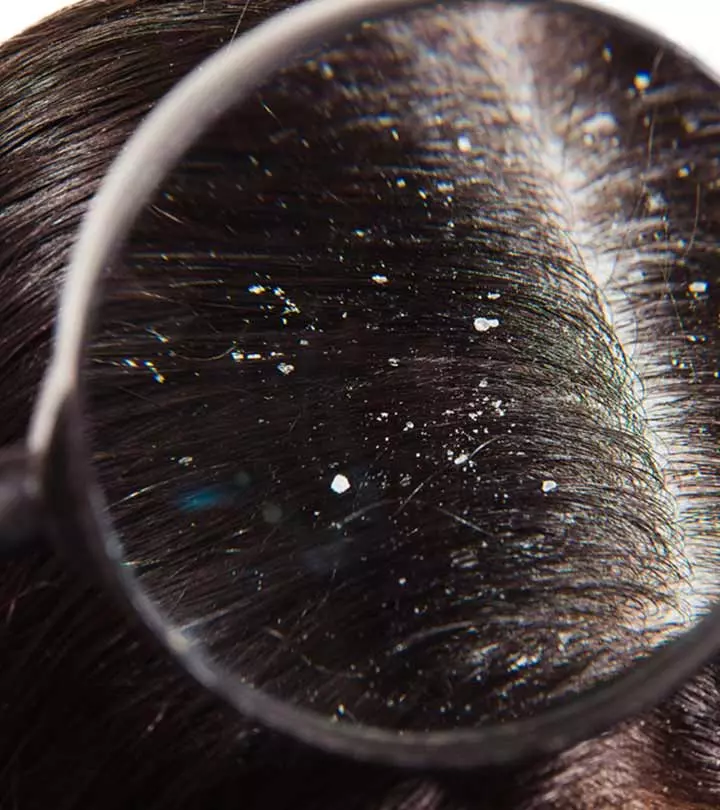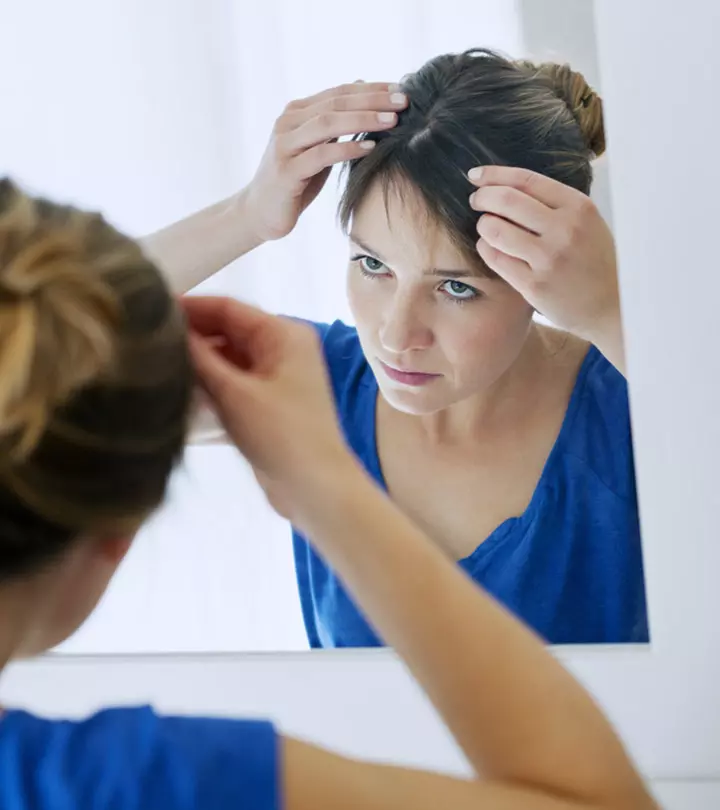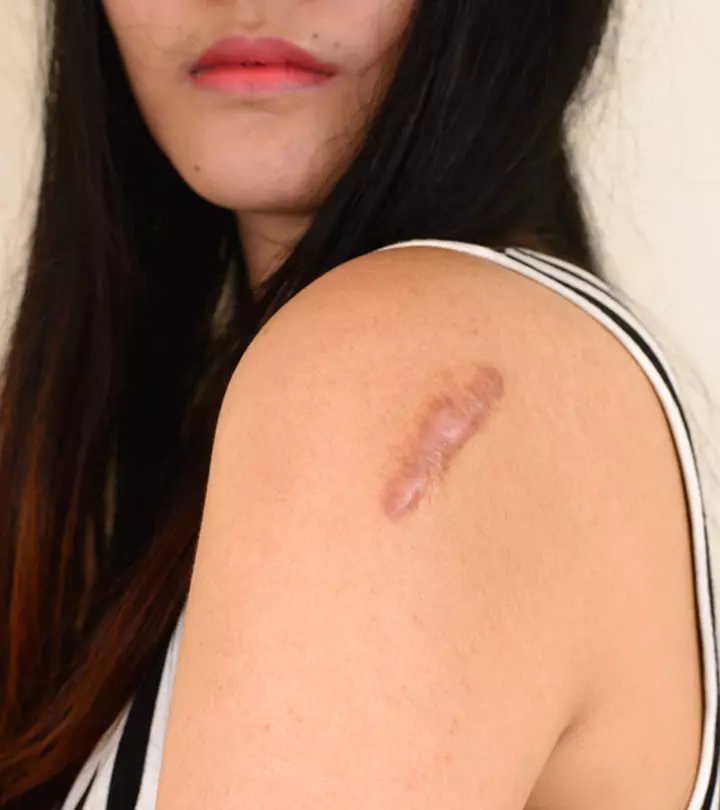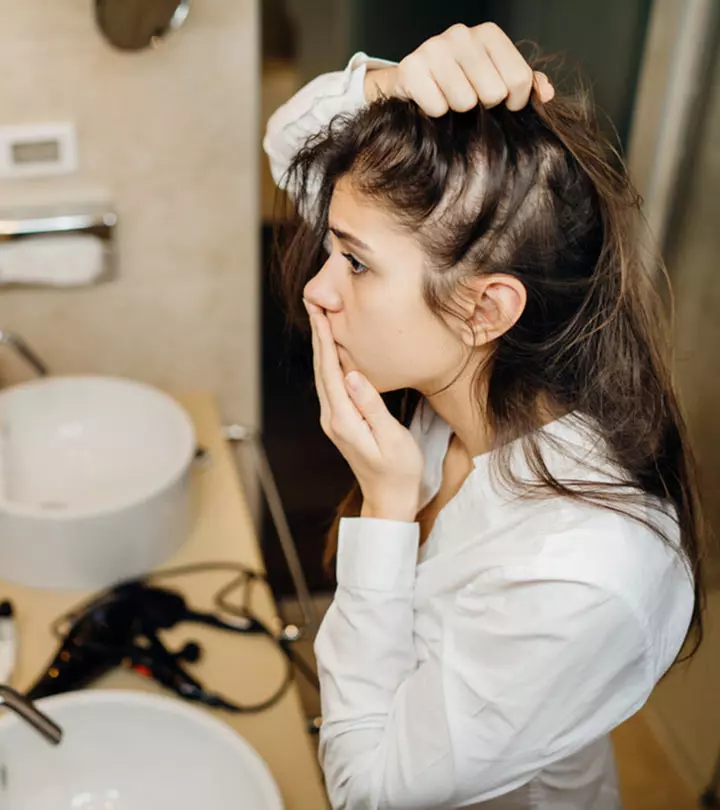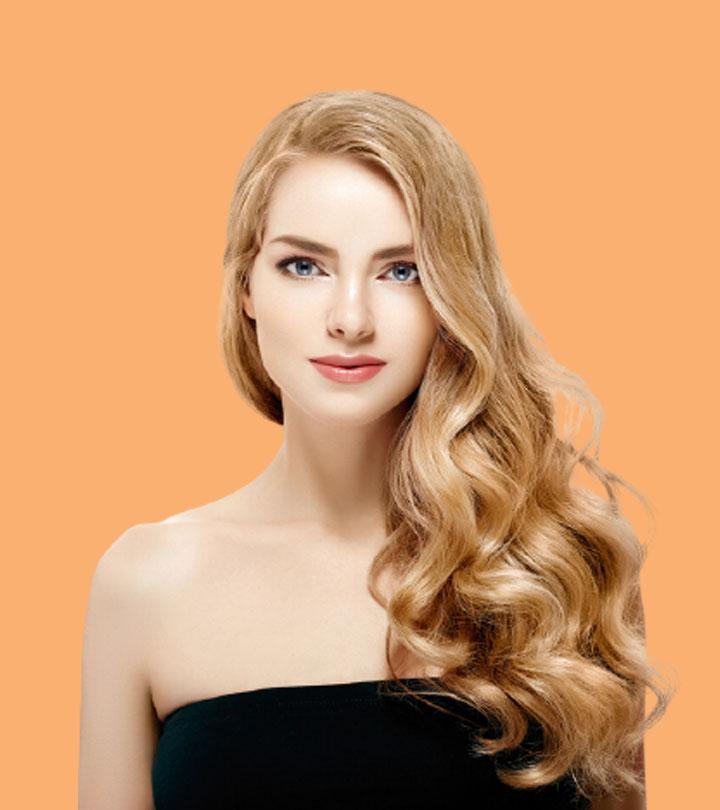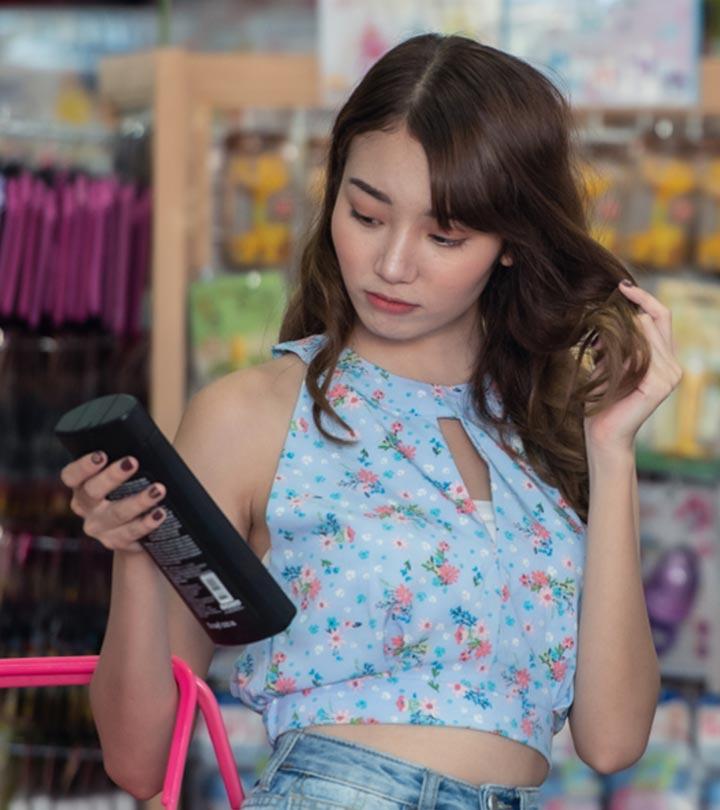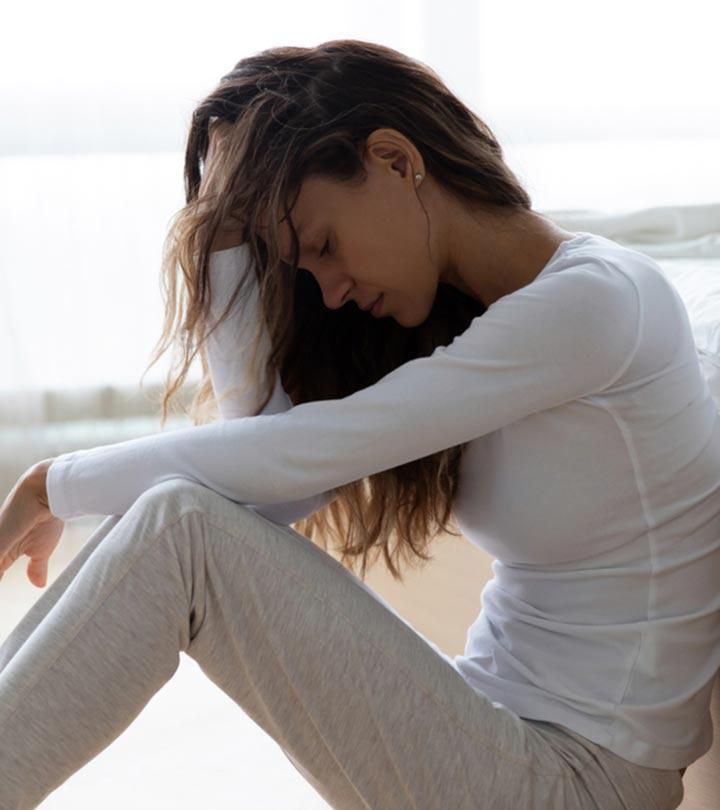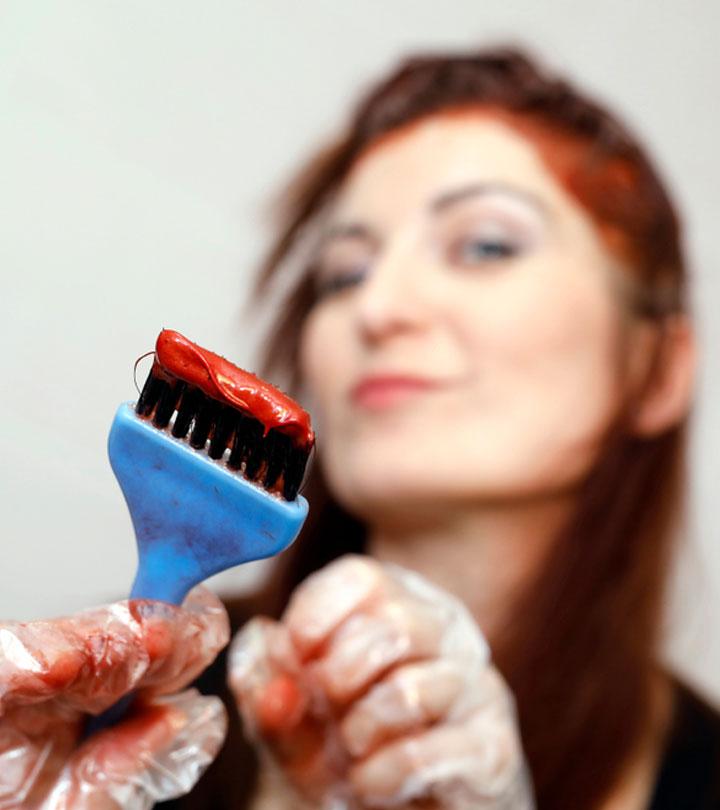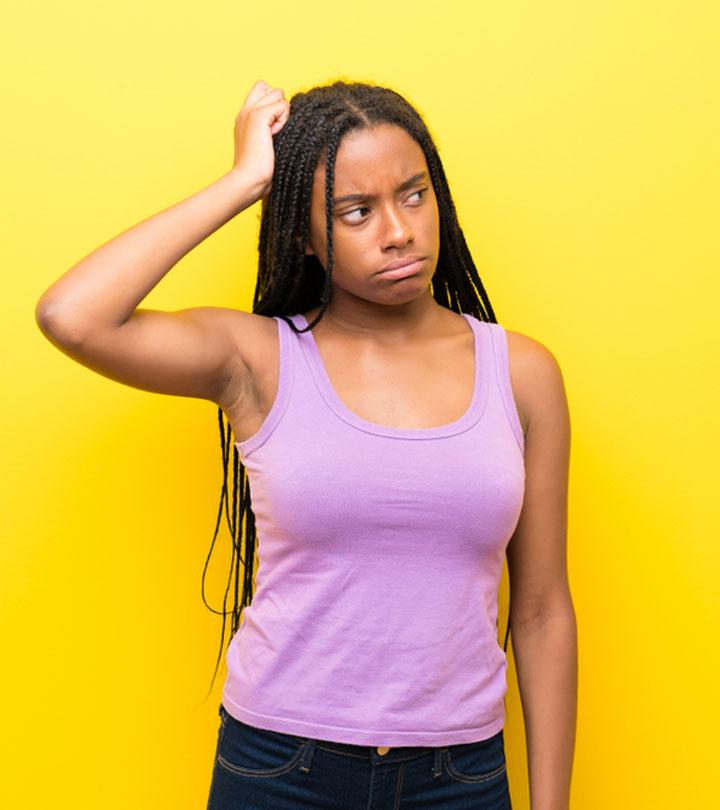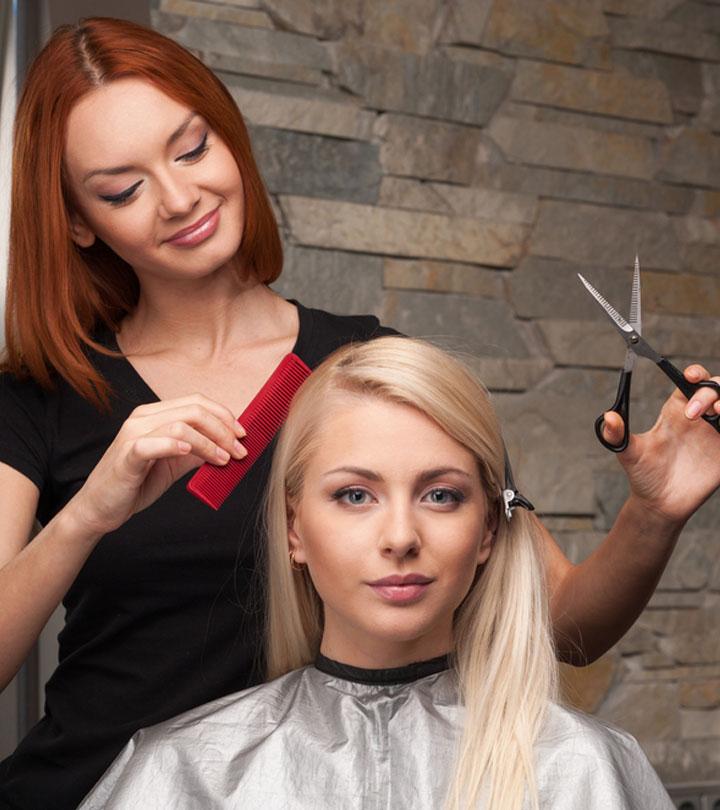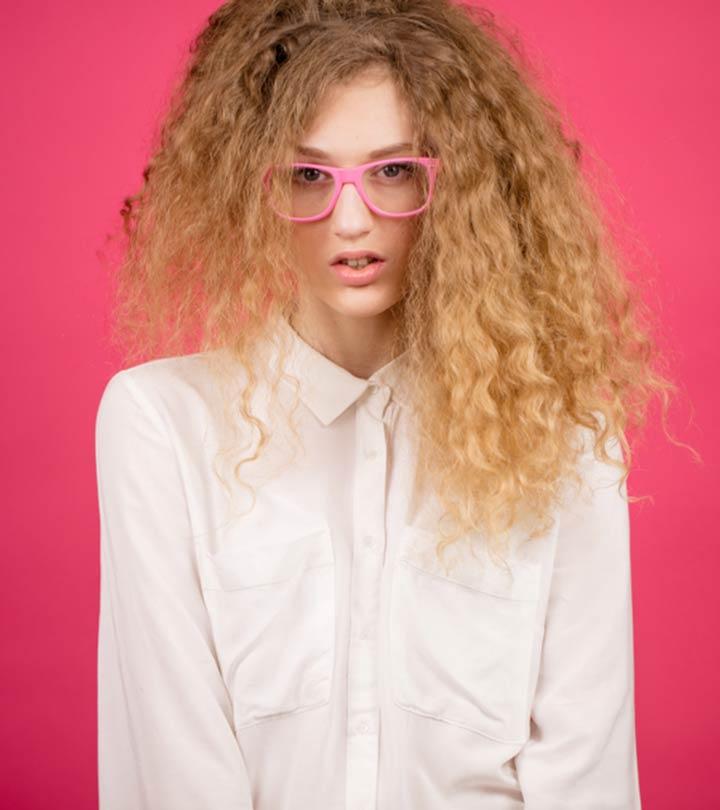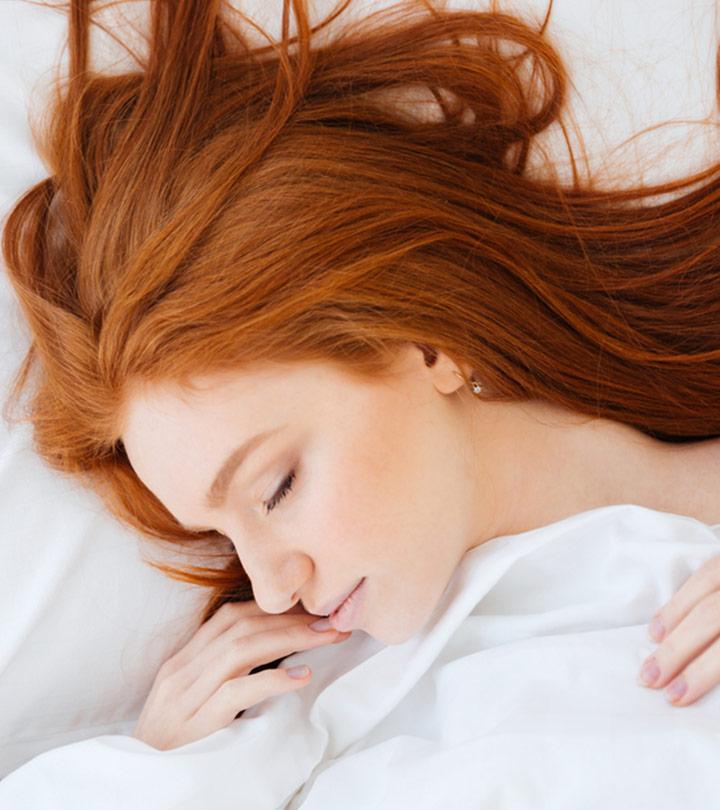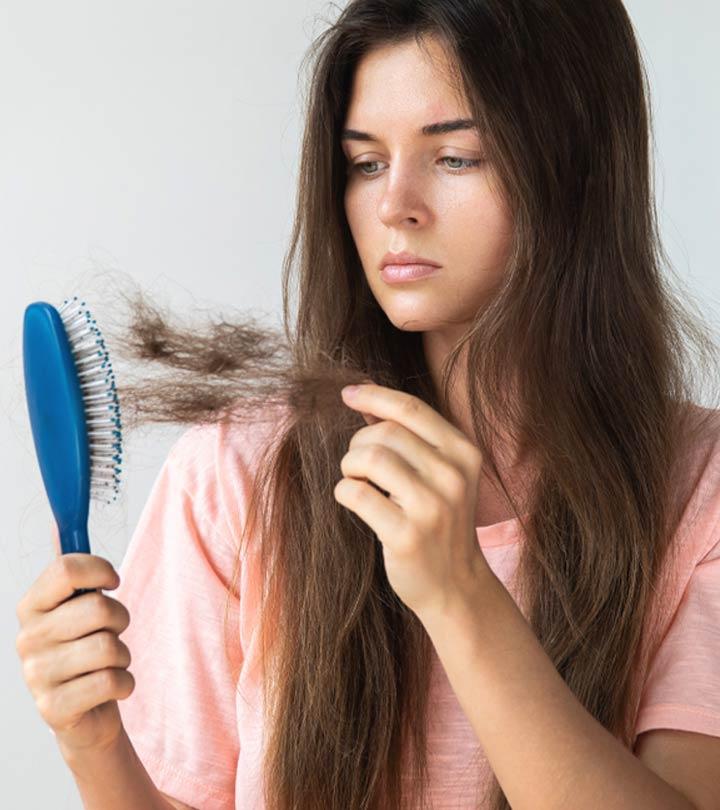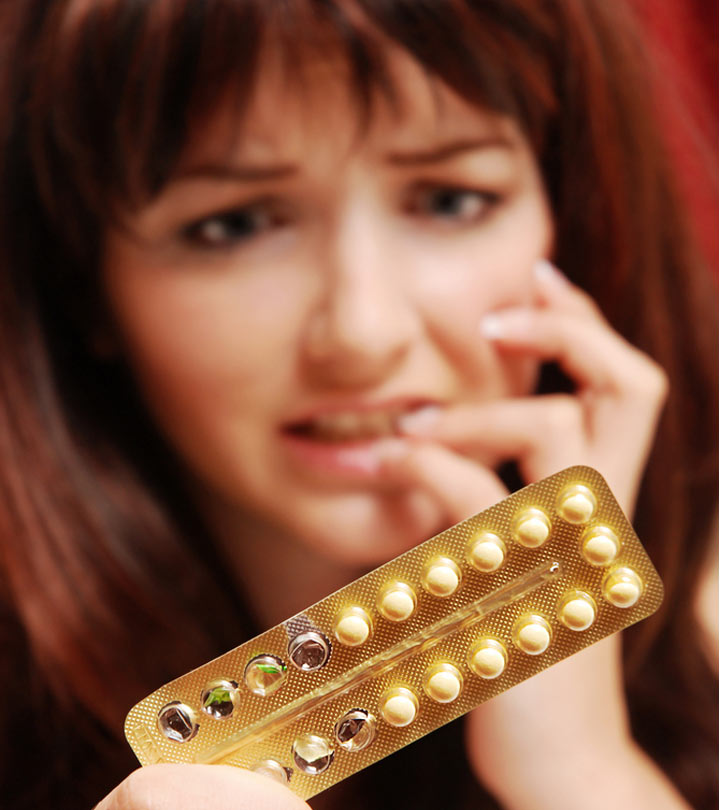Scalp Problems – Causes, Symptoms, Types, & How To Take Care
Say goodbye to your scalp woes with medicated products and clinical treatments.

Image: Shutterstock
There should be more awareness about the common scalp problems we face. These issues may arise due to improper scalp health and maintenance. Some scalp disorders cause serious inflammation leading to hair loss. Once you understand these scalp conditions and their triggers, you will be able to find the right treatment to fix them.
Keep reading to learn about the 11 important scalp problems you may face, their causes, treatments to consider, and tips to keep your hair and scalp healthy.
In This Article
Types Of Scalp Conditions – Causes, Symptoms, And Treatments
1. Dandruff
Dandruff is a common scalp disorder that nearly affects everyone irrespective of their age and gender (1). It mainly affects people at their puberty and middle age. Dandruff mainly affects the scalp and causes it to itch and flake without visible inflammation (2) .
Causes
It is most commonly caused by a fungus called Malassezia furfur. Research shows people with dandruff tend to have twice the concentration of this fungus as compared with those without dandruff (1). Dandruff may be caused by bacteria too.
- Other causes of dandruff include excess exposure to sunlight, harsh combing techniques, excessive shampooing, extreme weather conditions, hard water, and accumulation of dirt, grime, and product residue.
- The use of certain cosmetic products can also lead to dandruff.
- A dry environment can push your scalp into an overdrive, making it produce excess sebum, which may cause dandruff. Dandruff tends to feed on this excess sebum and spread.
Symptoms
- The major symptom of dandruff includes big white or yellowish flakes paired with excessive itching.
- The white-yellowish flakes may be oily or dry.
- There may or may not be inflammation.
- It only affects the scalp.
Treatment Options
- The best treatment for dandruff includes the use of anti-dandruff shampoos. Anti-dandruff shampoos contain salicylic acid, zinc pyrithione, selenium sulfide, keratinolytic agents, imidazole antifungal agents, hydroxy pyridones, and naturopathic agents (1). These ingredients have antifungal and antimicrobial properties.
- You can also try natural remedies like rosemary paired with a carrier oil to reduce dandruff (3).
Dorothy, a beauty and lifestyle vlogger, tried home remedies to treat her dandruff issue and shared her experience in her vlog. She said, “I use water remedies like this anti-fungal scalp toner with rosemary and pink salt to get rid of the bacteria and the excess oils on my scalp (i).”
 Did You Know?
Did You Know?2. Seborrheic Dermatitis
Seborrheic dermatitis affects the seborrheic areas of the body that produce more oil, including the face, chest, and scalp (2) , (4). It is similar to dandruff but has a few differences. Dandruff only affects the scalp, whereas SD affects other parts of the body too. SD is commonly characterized by flaking, scalp acne and inflammation, and pruritus. It is predominantly noticed during three age periods the first three months after birth (may appear as cradle cap), puberty, and in adulthood between the ages of 40 and 60 years. It is also considered a type of eczema.
Causes
One of the main causes is the overproduction of sebum.
- Another cause may be hormones. Notably, men appear to be more susceptible to SD than women. This suggests that there may be a relation between hormones like androgen and the occurrence of SD.
- Malassezia furfur, known to cause dandruff, may also be responsible for SD.
- SD also appears to be prevalent with people with medical conditions like lymphoma and HIV/AIDS.
- There also appears to be a connection between SD and neurological and psychiatric disorders like Parkinson’s disease, neuroleptic induced parkinsonism, tardive dyskinesiai Uncontrolled, involuntary erratic muscle movement of the face, arms, and legs due to low magnesium levels or muscle fatigue. , traumatic brain injury, epilepsy, facial nerve palsy, spinal cord injury and mood depression, chronic alcoholic pancreatitis, and hepatitis C virus.
- SD may also be noticed in people with congenital disorders like Down Syndrome.
- SD may also be associated with organ transplant recipients.
- SD may develop in people treated for psoriasis with psoralen and ultraviolet A therapy, commonly called PUVA.
- SD may also be caused due to medication like griseofulvin, ethionamide, buspirone, haloperidol, chlorpromazine, IL-2, interferon-α, methyldopa, and psoralens.
- Deficiencies of pyridoxine, zinc, niacin, and riboflavin may also cause SD.
SD affects only areas rich in oil like the scalp, the retro-auricular area (behind the ear), face (nasolabial folds, upper lip, eyelids, and eyebrows), and the upper chest.
Symptoms
- It is characterized by scaling, flaking, inflammation, and pruritus.
- The flakes noticed are whitish-yellow. They may be oily or dry.
- Erythematous greasy plaques may be noticed in areas with high oil production.
- Lesions noticed during SD are very symmetrical.
- Non-contagious or fatal lesions, inflammation, scaling, and flaking.
- SD has a seasonal pattern and is commonly noticed during winters. By summer, SD should have decreased.
- An increase in the characteristics of SD occurs due to sleep deprivation and stress.
- SD in adults may appear as a chronic or relapsing condition.
- Redness and irritation may be noticed when SD appears with a secondary bacterial infection.
A skin biopsy might be required to diagnose SD, specifically to determine the stage at which it occurs.
Treatment Options
- Antifungal and anti-inflammatory products like shampoos, foams, and lotions are used to treat seborrheic dermatitis on the scalp. Antifungal agents used in these products include zinc pyrithione and selenium sulfide.
- Medications like ketoconazole and bifonazole may be prescribed to treat scalp SD.
- Ciclopirox Olamine shampoos may be prescribed to treat SD.
- Topical anti-inflammatory corticosteroids like betamethasone dipropionate and fluocinolone may be applied to the scalp to treat SD.
- A 4% coal tar shampoo may be used as an antifungal and anti-inflammatory treatment. It also reduces sebum production.
- Oral medications like Itraconazole and terbinafine may be prescribed.
3. Atopic Dermatitis
Atopic dermatitis is the most common type of eczema. It is a chronic and relapsing inflammatory skin condition known to affect the scalp (5). It is said to affect one-fifth of all individuals worldwide. Approximately 50% of people with scalp eczema develop symptoms within the first year after birth, and around 95% have visible symptoms before they turn 5 (6). It affects approximately 9.6 million children and 16.5 million adults in America alone. AD is often noticed on the scalp in infants.
Other forms of eczema include contact dermatitis, dyshidrotic eczema,neurodermatitisi A neurological skin disorder that causes red, scaly patches on the neck, scalp, and feet accompanied by chronic itching. , nummular eczema, stasis dermatitis, and seborrheic dermatitis.
Causes
- In atopic dermatitis, the immune system becomes disordered and overactive. However, what triggers the immune system here is yet to be fully understood. The affected immune system causes inflammation that damages the skin barrier function. It makes the skin dry and itchy.
- Individuals with AD had shown a gene mutation that affects filaggrin production (filaggrin is the protein that maintains and regulates a healthy skin barrier function). Due to reduced filaggrin content, the skin loses its moisture and could allow the bacteria, fungi, and viruses to enter and cause infections or inflammation.
- Research suggests a connection between AD and hayfever and asthma (6). Individuals with hayfever or asthma (or their family members) generally develop AD.
- Studies show that AD and oxidative stress have an association (6).
- AD may also be caused due to environmental and genetic factors (7), (8). AD is aggravated by environmental issues like UV exposure, air pollutants, and changes in ozone levels.
- AD may also be triggered by infections, stress, and food allergies.
Symptoms
- Dry skin prone to itching.
- Rashes that appear purple, brown, or gray on dark skin tones and red on light skin tones.
- Skin infections.
- Dry, scaly lesions (8).
- Papules or spongiotic vesicles occur in severe cases.
- Skin thickening, visible skin lines, hyperpigmentation, and discoloration may be noticed in chronic conditions.
Complications
Atopic dermatitis leaves the skin open to other bacterial, viral, and fungal infections, leading to superinfections (9). Staphylococcus aureus, known to cause acne, is commonly noticed with AD. People with AD also have a deficiency in antimicrobial production and may develop fungal infections like herpes that may spread and affect the scalp. The fungi Malassezia may also aggravate atopic dermatitis flare-ups (4).
Treatments
Although there is no definitive cure for atopic dermatitis, a few treatment suggestions can help reduce the flare-ups and minimize the duration and intensity of the condition (9).
- To prevent any breakouts, make sure your skin is not dry. Use moisturizing creams, lotions, and other emollients to hydrate your skin.
- Avoid using products with irritant agents such as allergens.
- Avoid using harsh soaps and detergents (8).
- Avoid using non-cotton clothing, like wool, which may aggravate AD (8).
- Avoid taking long hot baths as they may dry your skin out. Moisturize your skin right after a bath to hydrate it and increase the skin barrier function.
- Corticosteroids may be prescribed in the management of AD breakouts.
- Acute or chronic eczema might require immunosuppressants drugs and phototherapy (PUVA).
4. Psoriasis
Psoriasis is a chronic inflammatory skin condition that affects the scalp. Psoriasis may occur at any age, though the major onsets occur between the ages of 20 and 60 years (10). Scalp psoriasis may occur on its own or along with other forms of psoriasis. It may cause reversible or irreversible hair loss. Research shows that scalp psoriasis has a debilitating effect on people, often leading to social and emotional stress (11).
Causes
Although the exact cause of psoriasis is yet to be determined, there are a few possible factors (12).
- Psoriasis may be caused due to genetic predisposition.
- Immune system changes may also cause psoriasis.
- Other internal and external factors like sunburn, systemic drugs, stress, mild trauma, and infections may also cause psoriasis.
Symptoms
- Well-defined erythematous plaques.
- Thick silver-white scales.
- Thickened red lesions along the hairline or the surrounding areas (forehead, posterior neck, and ears).
- May be paired with severe pruritus.
- Scales may fall off, resembling dandruff.
- Hair loss.
Treatment
- Salicylic acid shampoos, with keratolytic activity, are usually the first line of defense in psoriasis treatment. They enhance the absorption of other topical medications like corticosteroids.
- 05% clobetasol propionate shampoo is very effective in the treatment of psoriasis.
- Topical products containing either 5-10% salicylic acid, 5-20% coal tar solution, or 0.01-3% anthralin cream may be used. However, it is not advised to use coal tar on hair as it may cause adverse effects. Consult your doctor for clarity on the same.
- Topical corticosteroids are also used in the treatment of psoriasis.
- Vitamin D derivatives may also be used in the treatment of psoriasis.
- 50 mL of calcipotriol solution may be used twice daily to treat psoriasis.
- Systemic therapies may help manage psoriasis. Oral systemic drugs like Apremilast may be used effectively.
- TNF-inhibition, IL-12/23 inhibition, and IL-17a inhibition may help in managing psoriasis. Etanercept, Adalimumab, and Infliximab can be used for TNF-inhibition. Ustekinumab can be used in IL-12/23 inhibition. Ixekizumab and Secukinumab can be used for IL-17a.
- Physical therapies like UV or laser light therapies may be used.
5. Folliculitis
Folliculitisi Inflammation of the follicles (pockets from which hair grows) often caused due to a bacterial, viral, or fungal infection. decalvans is an inflammatory condition of the hair follicle (13). It has also been called a type of scarring alopecia that predominantly affects adults (14). It is characterized notably by reddened papules, inflamed pustules, and crusty lesions (15). They can even burst and cause blood and pus to come out of the bumps (16). Folliculitis can appear on the scalp, face, and neck. There are multiple subsets of this condition, such as infectious folliculitis, non-infectious folliculitis, and perifolliculitis (17). It is commonly noticed in men.
Causes
- The main cause of folliculitis is unclear. It is said to be caused by the inflammation of granulocytes that cause inflammation in the hair follicles and the scalp.
- It may also be caused by bacterial, viral, and fungal infections (17). It is commonly known to be caused by the bacteria Staphylococcus aureus.
- It may also be caused by non-infectious diseases
- Other causes of folliculitis include sweat, dirt, bacteria, and yeast infections.
Symptoms
- Red bumps on the scalp.
- Crusty lesions around affected areas.
- Affected areas may have red and inflamed borders.
- A group of 5 to 20 hair strands found bordering lesions.
- Lesions with hemorrhagic crusts and erosions.
- Swollen scales and scabs (18).
- Pus-filled bumps.
- Bald patches that may increase and lead to permanent scarring hair loss.
Treatment
- Antimicrobial shampoos should be used daily to reduce bacterial infections.
- Systemic antibiotic treatment with clarithromycin or doxycycline may be prescribed for about 4 to 8 weeks.
- An effective antibiotic treatment would be a combination of clindamycin 300 mg with rifampicin 300 mg that can be prescribed for 6 to 12 weeks.
- Anti-inflammatory drug Dapsone (50 mg) may be prescribed.
- In some cases, the lesions and surrounding tufts of hair may have to be surgically removed.
- Anti-inflammatory and antibacterial solutions may be prescribed along with oral antibiotics.
- Topical steroid products like creams and lotions may also be used.
- Photodynamic light therapy may also be used.
6. Lice
Lice infestations (pediculosis) are caused by head lice (Pediculus capitis). These lice are tiny wingless creatures, usually 2 to 4 mm long, that inhabit the scalp. They live on the scalps of humans and survive by sucking blood from the scalp. Lice infestations can be bothersome as they lead to itchy scalp. Each female adult louse can lay up to 3 to 5 eggs (nits) per day for a month (19). It takes about a month for the eggs to hatch and become adults. Hence, lice infestations need to be dealt with quickly.
The head lice secrete saliva, which makes the scalp itchy. Lice are transmitted mainly by direct contact from person to person. They cannot last beyond 3 to 4 days without inhabiting a scalp, as they need blood to survive. The eggs are attached to the hair shafts. Lice are usually found behind the ears and near the nape of the neck (20).
Causes
- Head lice can only be transmitted through direct contact (head to head).
- Head lice may be transmitted by contact with pillowcases, hats, and other head accessories.
Symptoms
- Presence of lice on the scalp, predominantly behind the ears and nape of the neck.
- There may be itchiness, although not always. Itching only occurs in sensitized scalps after 4 weeks from the onset of the infestation.
- Lice may also spread to eyebrows and eyelashes
Treatments
- Hydrate hair with oil, water, or a conditioner. Use a fine comb to comb through the hair and remove any lice. Repeat this about four times to confirm lice removal.
- Topical insecticides such as pyrethrins, permethrin 1%, and lindane may be used. Research indicates that permethrin, malathion, and synergized pyrethrins effectively treat head lice infestations (20). Permethrin-based shampoos are available, which have to be used as per your dermatologist’s instructions.
- Oral agents may be used, although there is very little data to back their usage.
- Alternative remedies such as mayonnaise, petroleum jelly, olive oil, tub margarine, and thick hair gel may help manage head lice. There is very little scientific evidence backing the usage of natural ingredients to eliminate lice. However, there is sufficient anecdotal evidence to suggest that while lice may not be eliminated, they may be managed (reduced) using natural remedies. Essential oils like tea tree oil may help reduce lice infestations.
- In a study conducted in Israel, a mixture of coconut oil, anise oil, and ylang ylang oil applied to hair thrice at five-day intervals could successfully treat lice in children (21).
- Diluted vinegar when applied for 30 minutes on the hair strands can help in the case of nits.
7. Dry Scalp
A dry scalp is characterized by itching and flaking. It might be a sign of pruritus (22). Research shows that scalp flaking is mainly caused by sebaceous activity (23). Factors like weather conditions, unbalanced sebum production, and improper hygiene may cause the scalp to go dry. Dry scalp can also be caused by medical conditions like psoriasis and eczema. It is commonly characterized by small white flakes.
Causes
- Research indicates that the flaking occurs on the scalp mainly because of sebaceous activity (23). The sebaceous glands produce sebum, a complex oil containing triglycerides and fatty acids, wax esters, squalene, cholesterol esters, and cholesterol. When there is less sebum secreted, the scalp becomes undernourished and flakes.
- Another cause of a dry scalp can be the overuse of shampoos that may dry your hair out.
- Excess use of hot water on the scalp can make it dry.
- Fungal and bacterial infections may also lead to a dry scalp.
- Excessive heat or cold can also lead the scalp to become dehydrated.
- Thermal damage from overuse of styling tools can cause the scalp to become dry.
- Hair dyes and colors can make the scalp dehydrated due to the chemicals used (24).
- Deep conditioning treatments, hot oil massages, and hair packs without the right hair care routine can dry the scalp out.
Symptoms
- Dry scalp can cause small white flakes.
- These white flakes may also be seen with redness or small bumps on the scalp.
Treatment
- The best treatment for a dry scalp is to moisturize the scalp with deep conditioners, oils, and hair masks.
- Keep your scalp moisturized by oiling it regularly.
- If you notice any dryness, use deep conditioning treatments.
- You can also try hydrating hair packs and masks.
8. Tinea Capitis
This condition is also commonly called the ringworm of the scalp. Tinea capitis is a mycotic scalp condition (25). It is only noticed in prepubescent children and, more recently, post-menopausal women. It can spread by exposure to desquamated cells (skin peeling). It can also be transmitted by people, animals, or soil. It may be inflammatory or non-inflammatory.
Causes
- It is commonly caused by fungi called dermatophytes. There are three categories of dermatophytes Microsporum, Trichophyton, and Epidermophyton. Microsporum and Trichophyton are known to affect hair follicles. These dermatophytes penetrate the hair follicles to extract keratin and grow (22).
- Since it is caused by a fungal infection, it occurs in people only through direct contact from infected people, animals, or soil.
Symptoms
- Inflammatory tinea capitis may appear as pustules or widespread abscesses.
- A painful mass, called kerion, may develop in inflammatory conditions.
- Alopecia and tender cervical and postauricular lymphadenopathy (abnormal size of the lymph nodes) may occur.
- Non-inflammatory capitis appears as round or oval patches of alopecia.
- Fine scaling may appear in non-inflammatory conditions.
- Prominent cervical and postauricular adenopathy (swelling of glands) may occur in non-inflammatory conditions.
- Ectothrix infections (infections just beneath the hair cuticle) may appear as spores outside the hair shafts, which causes cuticle breakage near the scalp.
- Endothrix infections (infections entering the hair cell) cause spores to affect the hair cortex from within. This leads to black dot alopecia. It may also be seen with scaling or inflammation.
- Some dermatophytes, causing ectothrix infections, may also cause scalp fluorescence.
Treatments
- Systemic antifungal agents like griseofulvin, itraconazole, fluconazole, or terbinafine are often prescribed to treat TC. Treatment is continued until hair regrows
- Antifungal shampoos containing pyrithione zinc, selenium sulfide, or ketoconazole, should be used by the patient and their family members to prevent re-infection.
- Once the source of infection is found (animal or human), oral antifungal supplements may be used for treatment.
- Woods lamp detection may be used to spot tinea capitis caused by microsporum (a genus of fungi).
9. Pruritus
Pruritus, also called itching, is a common symptom seen in various skin conditions and systemic disorders (26). Itching on the scalp can be very irritating and aggravating. It causes people to scratch the scalp, leading to bruising.
There are four types of itches cutaneous, neuropathic, neurogenic, and psychogenic. A cutaneous itch, also known as pruritoceptive itching, is caused by skin inflammation. A neuropathic itch forms in an afferent nerve pathway that is caused by nervous system damage. It is noticed in herpetic neuralgiai Sharp, shocking pain caused by a damaged or irritated nerve that is commonly associated with shingles or diabetes. , multiple sclerosisi A disease where the immune system attacks the myelin sheath (protective covering of nerve fibers), affecting the central nervous system. , and brain tumors. A neurogenic itch originates centrally without causing any neuronal function impairments or degeneration. A psychogenic itch is noticed in delusional conditions like parasitophobia.
Causes
- It may be caused due to dandruff, scabies, skin cancer, and other scalp infections and diseases (27).
- Histamines are also known to cause itching. Histamine is a chemical found in body cells that cause adverse reactions like runny nose or allergies.
- Serotonin, an amine compound in platelets, also causes itching. It is released in the body when the platelets are aggravated and act on certain receptors that cause itching.
- A neurotransmitter called acetylcholine is known to cause flare-ups like itching. It aggravates certain fibers (also called C-fibers in the body). Itching is only noticed in atopic patients.
- Prostaglandins (compounds with hormone-like effects) may also cause scalp itching.
- Some plants covered in cowhage may cause pruritus. They have barbed hair on the outside pods that can penetrate humans and animals.
- Mechanical factors such as heat and xerosis (dry scalp/skin) may also cause itching.
- Some systemic diseases may be associated with pruritus (like chronic renal failure). Oral contraceptives, extrahepatic biliary obstruction (blockage of bile from the liver to the intestinal tract), hepatitis, and drugs may also lead to itching. Hematopoietic diseases like polycythemiai A rare disorder characterized by an increase in red blood cells that could be a possible sign of blood cancer. vera, Hodgkins disease, multiple myeloma, mastocytosisi A rare disorder where the immune cells are activated and accumulate in the body tissues, leading to itching and flushing. , and iron deficiency anemia may cause pruritus. It may also be caused by endocrine diseases like thyrotoxicosis, hypathyroid, and carcinoid.
- Other miscellaneous disorders that cause pruritus are asthma, atypical angina, and tumors.
- Some foods like bananas and coffee are known to cause itching.
- Opiates and other drugs may also cause itching.
Symptoms
- Constant itching sensation.
- May have inflammation.
- Scratching to the point of pain for relief.
- Itching leading to redness.
- Itching may cause scars and lesions.
- Lichenified (thick and leathery) plaques on the scalp.
- Beveled nails due to excessive scratching.
- Primary skin lesions with secondary lesions due to scratching.
Treatments
- Treatments will vary depending on the scalp condition causing it.
- Though antipruritic tablets may be prescribed, they may not work for everyone.
- Emollients like petroleum jelly hydrate the scalp and prevent any dryness that may cause itching.
- Avoid hot baths and use mild shampoos and soaps.
- Avoid contact irritants and non-cotton clothing like woolen caps.
- Ice compresses and cold water soothe itching.
- Antihistamines lead to sedation and may prevent excessive scratching. However, they do not work for everyone.
- Psychotropic agents may be used to treat itching.
- Topical therapies such as corticosteroids, capsaicin cream, and menthol, aspirin solutions, salicylic acid solutions, and phenol may be used to treat itching.
- UVB therapy and cutaneous field stimulation may also be used to treat itching.
- Other topical agents like gabapentin, thalidomide, antidepressants, kappa opioid receptor antagonist, fluoxetine, and cholestyramine may be used too.
10. Sores
Sores are small lumps or bumps formed on the scalp due to many skin conditions like folliculitis, seborrheic dermatitis, and most of the above-mentioned scalp issues. Sometimes these bumps may be filled with blood or pus and may even burst. These sores may be painful and might even cause inflammation, lesions, or scarring.
Causes
- It appears as a symptom of other skin conditions.
Symptoms
- Small lumps or bumps
- Redness
- Lesions
- Scarring
- May have inflammation
Treatments
- Treatments are very specific to the scalp condition causing the sores.
11. Lichen Planus
Lichen planus is a persistent inflammatory skin ailment that can impact various parts of the body, including the scalp. This condition is predominantly observed in individuals aged between 30 and 70 years, with a higher incidence rate in women.
Causes
The condition is thought to result from an autoimmune response to an allergen or viral infection that triggers the immune system to attack healthy skin cells (28).
Symptoms
- Itchy scalp
- Red or yellow-gray bumps
- White, lacy patches
- Hair loss
- Burning sensation or soreness
- Scalp tenderness
- Scaly or flaky skin
Treatment
- Topical corticosteroids
- Topical calcineurin inhibitors, antihistamines, and phototherapy
- Severe cases may require systemic corticosteroids or other immunosuppressive drugs.
- Maintain good scalp hygiene and avoid potential triggers.
Scalp health is important when it comes to protecting the scalp from these conditions. These issues may be caused by an unhealthy scalp. Some of these issues like dandruff might make the scalp unhygienic. Here is how you know your scalp health has been compromised.
Scalp Health
An unhealthy scalp shows surface pitting, roughness, cuticle rigidity, or breakage. There may also be oxidative damage caused by free radicals. Factors like environmental conditions, dirt, clogged pores, product residue, irregular hair washing, and poor hair care can hurt scalp health. An unhygienic scalp is more prone to skin infections and infestations.
There may be a connection between age and scalp health. Read on to know how age affects the scalp.
Scalp Aging – Does Age Affect Scalp Health?
Your skin ages going through years of changes. This leaves the scalp vulnerable to some of the above-mentioned conditions. Scalp aging is often unseen due to the presence of hair. Over time, the scalp becomes pale and dry. Bald scalps exhibit more signs of aging like photo-aged skin, irregular pigmentation, wrinkling, atrophy, and telangiectasiai Small, widened, and dilated blood vessels on the skin surface or the mucous membrane that cause thread-like patterns on the skin. . They may also carry a higher risk of cutaneous premalignant and malignant diseases such as actinic keratosis, basal cell carcinoma, and squamous cell carcinoma. Solar elastosis (degeneration of the elastic tissue in the scalp) may lead to androgenic alopecia.
The scalp may also show signs of sun damage, such as thickened skin, unevenly spread melanocytes, and inflammation. Scalp skin becomes thinner and easily damaged due to a decrease in volume and elasticity. Aged skin also reduces the skins healing capacity.
There is an increase in oxidative stress in the scalp due to the overproduction of free radicals. This affects the stem cells that control hair production and hair pigmentation. Scalp aging may eventually result in hair loss.
While you cannot stop scalp aging, you definitely can follow certain tips for better scalp care.
Scalp Care Tips
- Wash your hair a maximum of twice a week. Over- or under-washing your hair may lead to dryness or greasiness. Washing your hair with shampoo twice a week removes all dirt, grime, product residue, and the effects of daily pollution.
- Use hair care products that suit your scalp. If you have an oily scalp, pick refreshing and cleansing shampoos and conditioners. If you have a dry scalp, opt for hydrating hair care products.
- Oil your hair and scalp regularly. When you oil your scalp and massage it, it improves blood flow. It also helps unclog pores covered by dirt and product residue.
- Do not apply conditioner to the scalp. Conditioners contain ingredients in concentrated amounts that may cause scalp irritation or other adverse effects.
- When combing your hair, dont brush against the scalp harshly. It may otherwise cause scratches on the scalp. Comb your hair gently and ensure the comb only lightly touches the scalp.
- If you notice any scalp irritation, redness, severe dandruff (even after using anti-dandruff shampoos), and inflammation, please consult a dermatologist. Dermatologists treat skin conditions, including scalp issues.
 Quick Tip
Quick TipInfographic: What Shampoo And Conditioner To Use For Your Scalp Type
Now you know all the issues your scalp can face. One of the best ways to decrease the risk of these problems affecting your scalp is to use the right hair care products. We use shampoo and conditioner regularly, but using the wrong kind of product for your scalp type can lead to some serious issues.
Check out the infographic below to learn about which shampoo and conditioner you should use for your scalp type. Scroll down! Illustration: StyleCraze Design Team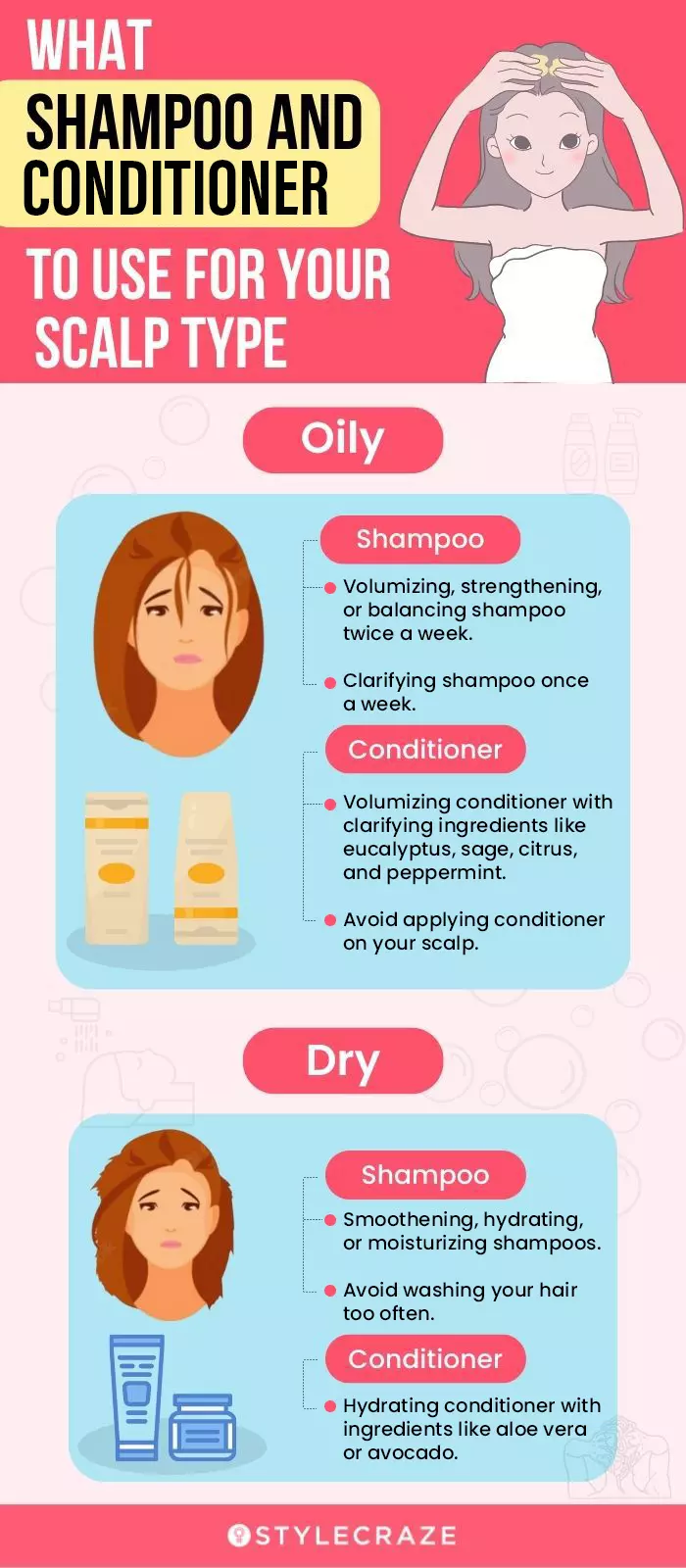
Maintaining a healthy scalp is essential to preventing many scalp problems, such as dandruff, seborrheic dermatitis, atopic dermatitis, psoriasis, folliculitis, scalp acne, scalp rash, and lice. Poor hair care, environmental conditions, and product residues may lead to an unhygienic scalp, which causes many scalp infections. However, washing your hair a maximum of twice a week, using the right hair care products that are suitable for your hair type, and oiling your scalp and hair regularly may help promote scalp and hair health. Hence, maintain proper scalp hygiene and consult your doctor in case of any scalp infections.
Frequently Asked Questions
What foods cause scalp inflammation?
Foods rich in sugar, refined carbs, and trans fats may increase inflammation. An increased intake of alcohol can worsen inflammation too.
Should I wash my hair everyday if I have scalp psoriasis?
No. If you have scalp psoriasis, you should wash your hair twice or thrice a week to remove any scaling or flaking and to keep your scalp fresh.
Can scalp infection spread to the brain?
A scalp infection such as scalp folliculitis or cellulitis when left untreated may cause the bacteria to spread to the brain. The bacteria can enter the bloodstream and damage the brain and other organs. One study found that even a mild scalp infection can lead to a cerebral abscess if not treated properly (29).
Is coconut oil good for hair fungus?
Coconut oil has antifungal and antibacterial properties that may be effective against scalp infection (30). You may massage this oil onto your scalp twice daily for the best results.
Is curd good for fungal infection?
Curd or yogurt contains bacteria that help promote a healthy microbial population in our bodies. The topical application of curd can help tackle irritation, itching, dryness, and fungal infections (31).
Can scalp problems be caused by using certain hair products or treatments?
Harsh chemicals and irritants can make sensitive skin prone to dryness, sebum production, and rashes. This can result in inflammation and scalp problems like dandruff and hair fall.
Can stress or anxiety contribute to scalp problems?
Stress and anxiety can cause various physical reactions in the body, most commonly acne. On the scalp, stress, and anxiety can aggravate sebum production, scalp folliculitis, dandruff, and seborrheic dermatitis (32).
Are there any vitamins or supplements that can help improve scalp health?
Biotin, vitamin D, zinc, omega-3 fatty acids, iron, and vitamin E are some ingredients that may help soothe skin inflammation and promote scalp and hair health (33).
Which soap is best for fungal infection?
Soaps with anti-fungal ingredients like ketoconazole, ciclopirox, and clotrimazole are ideal for fighting fungal infections and seborrhoeic dermatitis (34).
Can certain hairstyles, such as tight braids or ponytails, worsen scalp problems?
Tight braids lead to stress on the scalp. Also, close-knit hairstyles with improper air circulation can worsen scalp conditions, especially during summer. It is best to let your hair loose once in a while, wash it properly, and let it dry naturally before you opt for protective hairstyles.
Key Takeaways
- Dandruff is one of the major scalp problems, and it is caused by Malassezia furfur fungus. Harsh combing and excess shampooing can also trigger scalp issues.
- Scalp care tips like washing the hair twice a week and using suitable scalp products can minimize scalp problems.
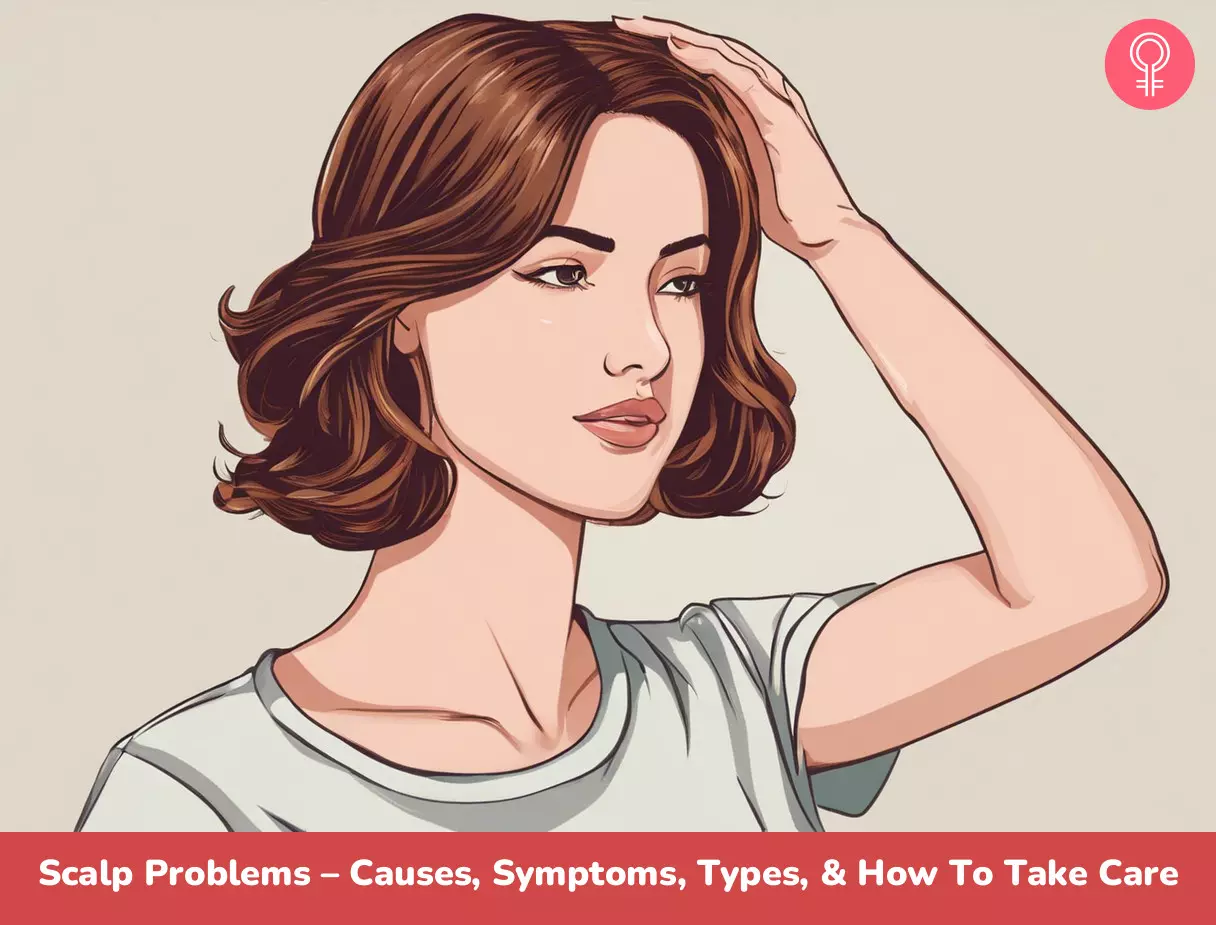
Image: Stable Diffusion/StyleCraze Design Team
Struggling with a flaky scalp? Learn the crucial differences between dandruff and dry scalp and gain insights on how to effectively treat and manage each condition from this informative video.
Personal Experience: Source
StyleCraze's articles are interwoven with authentic personal narratives that provide depth and resonance to our content. Below are the sources of the personal accounts referenced in this article.
i. DANDRUFF CARE MISTAKES THAT WILL RUIN YOUR HAIR! | How to remove dandruff properlyhttps://www.youtube.com/watch?v=kT26M2tcR9k
References
Articles on StyleCraze are backed by verified information from peer-reviewed and academic research papers, reputed organizations, research institutions, and medical associations to ensure accuracy and relevance. Read our editorial policy to learn more.
- Dandruff: The Most Commercially Exploited Skin Disease
https://www.ncbi.nlm.nih.gov/pmc/articles/PMC2887514/ - Seborrheic Dermatitis And Dandruff: A Comprehensive Review
https://www.ncbi.nlm.nih.gov/pmc/articles/PMC4852869/ - To Study The Antidandruff Activity Of Rosemary Oil Basil Oil Coleus Oil Over Selenium Sulfide
https://www.semanticscholar.org/paper/To-study-the-antidandruff-activity-of-rosemary-oil%2C-Patil-Gadekar/70242df2ea04bc5af510e6181e38d888b196101e? - Seborrheic Dermatitis
https://www.ncbi.nlm.nih.gov/pmc/articles/PMC2888552/#:~:text=Seborrheic%20dermatitis%20is%20a%20common - Atopic Dermatitis
ma/atopic-dermatitis/https://nationaleczema.org/eczema/types-of-ecze - Scalp Condition Impacts Hair Growth And Retention Via Oxidative Stress
https://www.ncbi.nlm.nih.gov/pmc/articles/PMC6369642/ - Atopic Eczema
https://www.rcpjournals.org/content/clinmedicine/16/1/66.full.pdf - Pathophysiology And Management Of Mild To Moderate Pediatric Atopic Dermatitis
https://www.jpedhc.org/article/S0891-5245(17)30357-7/pdf - Atopic Dermatitis: Natural History Diagnosis And Treatment
https://www.hindawi.com/journals/isrn/2014/354250/ - Management Of Scalp Psoriasis: Current Perspectives
https://www.ncbi.nlm.nih.gov/pmc/articles/PMC5683126/ - Scalp Psoriasis: An Overview Of The Disease And Available Therapies
https://pubmed.ncbi.nlm.nih.gov/20684141/ - Global Report On Psoriasis
https://iris.who.int/bitstream/handle/10665/204417/9789241565189_eng.pdf.psoriasis;jsessionid=54912784D28C9F36ECCD45471AC5775B?sequence=1 - Special Types Of Folliculitis Which Should Be Differentiated From Acne
https://www.ncbi.nlm.nih.gov/pmc/articles/PMC5821164/ - Folliculitis Decalvans
https://pubmed.ncbi.nlm.nih.gov/18715292/ - The Diagnosis And Treatment Of Hair And Scalp Diseases
https://www.ncbi.nlm.nih.gov/pmc/articles/PMC4908932/ - A Brief Review on Acne Vulgaris
https://www.researchgate.net/profile/V-N-Nerella/publication/338262719_A_Brief_Review_on_Acne_Vulgaris/links/61fd6b67b44cbe42272162ce/A-Brief-Review-on-Acne-Vulgaris.pdf - Differential Diagnosis Of The Scalp Hair Folliculitis
https://pubmed.ncbi.nlm.nih.gov/22384776/ - Keloid and Hypertrophic Scars Are the Result of Chronic Inflammation in the Reticular Dermis
https://www.ncbi.nlm.nih.gov/pmc/articles/PMC5372622/ - Head Lice Infestations: A Clinical Update
https://www.ncbi.nlm.nih.gov/pmc/articles/PMC2724133/ - Pediculosis Capitis (head Lice)
https://www.gov.mb.ca/health/publichealth/cdc/protocol/pediculosis.pdf - The In Vivo Pediculicidal Efficacy Of A Natural Remedy
https://pubmed.ncbi.nlm.nih.gov/12389342/ - A Practical Guide To Scalp Disorders
https://www.sciencedirect.com/science/article/pii/S0022202X15526572 - The Role Of Sebaceous Gland Activity And Scalp Microfloral Metabolism In The Etiology Of Seborrheic Dermatitis And Dandruff
https://www.jidsponline.org/article/S0022-202X(15)52586-4/pdf - Local side effects caused by hair dye use in females: cross-sectional survey
https://pubmed.ncbi.nlm.nih.gov/22417994/#:~:text=In%20addition%2C%2074%25%20(262 - Clinical Diagnosis Of Common Scalp Disorders
https://www.sciencedirect.com/science/article/pii/S0022202X15525852 - Pruritus
https://www.ncbi.nlm.nih.gov/pmc/articles/PMC2924137/ - 10 Reasons Your Scalp Itches And How To Get Relief
https://www.aad.org/public/everyday-care/itchy-skin/itch-relief/relieve-scalp-itch - Lichen Planus
https://www.ncbi.nlm.nih.gov/books/NBK526126/ - Cerebral Abscess Secondary to Mild Scalp Infection: A Case Report and Literature Review
https://www.omicsonline.org/open-access/cerebral-abscess-secondary-to-mild-scalp-infection-a-case-report-andliterature-review-2314-7326-S1-005.php?aid=57728 - Longitudinal study of the scalp microbiome suggests coconut oil to enrich healthy scalp commensals
https://www.ncbi.nlm.nih.gov/pmc/articles/PMC8012655/ - Antifungal Activity of Lactic Acid Bacteria Combinations in Dairy Mimicking Models and Their Potential as Bioprotective Cultures in Pilot Scale Applications
https://www.ncbi.nlm.nih.gov/pmc/articles/PMC6090892/ - Stress and seborrheic dermatitis
https://pubmed.ncbi.nlm.nih.gov/18033062/ - Diet and hair loss: effects of nutrient deficiency and supplement use
https://www.ncbi.nlm.nih.gov/pmc/articles/PMC5315033/ - Topical antifungals for seborrhoeic dermatitis
https://www.ncbi.nlm.nih.gov/pmc/articles/PMC4448221/
Read full bio of Dr. Swati Mutha
Read full bio of Eshna Das
Read full bio of Krati Darak






